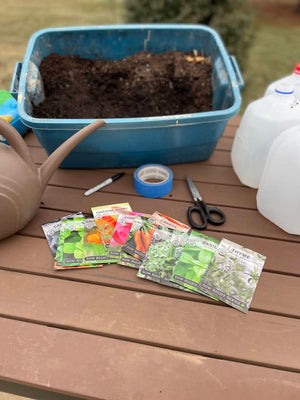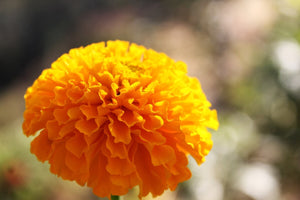Topics
How to grow poppies from seed for your own superbloom!
PoppiesPoppies are a beautiful flower that readily self-sow and creates an impressive landscape for years. Growing poppies is so easy that you really only need to know when and how to plant poppy seeds. Once they have been planted, these delicate but independent flowers will continue growing and self-seed so they can impress you year after year.

There’s something compelling about growing poppies from seed. They are so self-sufficient that they can grow on hillsides and roadways. Poppies create an impressive colorful display when blooming in mass. But up close, each individual poppy bloom looks so fragile and delicate.
There are many varieties of poppy flowers. However, our growing guide will focus on the easiest poppy plants to grow, California (Eschscholzia californica) and Oriental (Papaver orientale). These poppies are a natural choice for cottage gardens and wildflower landscapes.
Plant poppies for bees. The pollen in poppies provides protein and nutrients that bees need.
How to Grow Poppies from Seed
Preparing the Soil for Poppies
There’s not a lot you have to do to prepare the soil for growing poppies. California poppy plants thrive in what is often considered poor soil. It drains well and is fairly sandy. However, Oriental poppy plants will do better with more fertile soil.
Both Oriental and California poppies need well-draining soil. Clay soil will hold too much water and keep the roots soggy.
Choosing the best location for growing poppies
All poppy plants need full sun. So choose a location where the poppies can have a minimum of 6 hours of daily sunlight. For the best flowering, 8 hours is even better.
Which variety of poppy should I grow?
Whether you grow California or Oriental, poppy may depend on what colors and petals you like.
Oriental poppy (Papaver orientale) boasts brightly colored crepe paper-like flowers that reach 4 inches in diameter on plants 30 to 40 inches tall. Oriental poppies bloom in spring to early summer and go dormant until foliage reappears in the fall. The blooms attract bees, butterflies, and hummingbirds. This heirloom perennial readily self-seeds and is an ideal flower for cool winter climates.
California Poppy (Eschscholzia californica) is the state flower of California. This poppy has sunny, saucer-shaped flowers that bring cheerful color to your garden during late spring and early summer. This heirloom poppy is easy to grow even in poor soil.
Purple Gleam Poppy (Eschscholzia californica) grows 12 to 18 inches tall. It blooms profusely with 2-inch flowers in shades of purple with a contrasting yellow-to-white center. It self-sows easily and adds a bright splash of color to a sunny garden.
White Linen Poppy (Eschscholzia californica) is a creamy white variation of the California poppy. The blooms are 2 to 3 inches wide, and the plants grow 12 to 18 inches tall. Bees love this elegant wildflower.
Corn Poppy (Papaver rhoeas) is an extremely popular wildflower that grows 12 to 24 inches tall. This mixed collection of seeds includes white, red, and pink flowers. Corn poppies have blooms that reach 2 to 4 inches and make any garden spring to life.
Planting Poppy Seeds
Direct sow poppy seeds outdoors when the soil is warm enough to cultivate. A temperature of 60ºF is best for poppy seed germination.
Poppy seeds can also be successfully sown in the fall and winter. Try our method of winter sowing.
Light is required for germination, so gently press the poppy seeds into the soil without covering them more than 1/8 of an inch.
Keep the poppy seeds moist but not soggy.
Once the poppy seedlings emerge in 14 to 21 days, thin the seedlings to a spacing of 6 to 8 inches apart.
Maintaining Poppy Plants
There really isn’t much to do to maintain Oriental and California poppies. They will grow and bloom in their regular season as long as they have full sun.
Water - Poppies don’t need a lot of water. More often, too much water is a problem with poppies. In locations with clay soil, roots can become waterlogged and rot.
Regular watering when they are first growing will help them get established roots. Then restrict water to encourage deep root growth. Once established, poppy plants can tolerate drought.
Fertilizer - Poppies won’t need additional fertilizer during the growing season.
Deadheading - Removing spent blooms will encourage the poppies to continue growing. Cutting the flowers will keep them producing new blooms and prevent the plants from developing seed pods. Each poppy bloom only lasts a few days, but the plant will continue to produce fresh flowers.

Harvesting poppy flowers
Poppy flowers are a beautiful addition to bouquets and arrangements. Their delicate petals and thin stems lend an airy feel to both formal and wildflower mixes.
To use fresh poppies in flower arrangements, cut them in the early morning when the buds are just beginning to unfurl. Then, sear the cut ends with a flame or dip them in boiling water.
The dried seed pods can also be used in floral decor and add a unique shape.
As soon as bees have pollinated the poppy flower, it will drop its petals, and the seed pod will quickly develop. If you want to use these for decorations, cut them off once they are dry.

Poppy Frequently Asked Questions:
Do poppies come back every year?
California and Oriental poppies are perennials and will last several years in climates with mild winters. However, if poppies are allowed to self-sow in any location, they will come back year after year.
Are poppies hard to grow?
California and Oriental Poppies are easy to grow. They just need full sun and well-draining soil.
Where is it best to plant poppies?
The best place to plant poppy plants is in a location with full sun. However, since they readily self-seed, you may also want to choose a location where poppy plants can grow a little wild.
What month do you plant poppy seeds?
You can plant poppy seeds in March through May, depending on the temperature. You can also plant poppy seeds in the fall between August and October, and then they will grow and bloom in the spring.
Should I deadhead poppies?
Deadheading or cutting off the poppy blooms will keep them flowering and prevent them from going to seed. However, if you want to enjoy the unique seed pods, leave the blossoms on the plant to allow the seed pods to develop fully.
Will poppies grow in containers?
Poppies can be grown in containers. As with all container growing, you need to ensure that the soil drains well. Planters can heat up and dry out quickly, so more watering is necessary for growing poppy plants in pots.
If you love the look of poppies, try growing some heirloom varieties. These self-sufficient flowers will reward you with an impressive display of colorful poppy blooms year after year.
Popular Posts
-

Winter Sowing - Start Your Seeds Now for Faster, Simple Growing
-

5 Reasons We Love Marigolds and How to Grow Them From Seed







Leave a comment